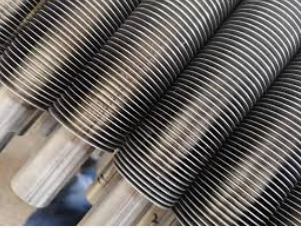Finned tube is a heat transfer enhancement element. By adding fin structure on the outer surface, it significantly expands the heat transfer area and optimizes the fluid dynamics performance, becoming a core component for improving energy efficiency in modern industry. Its design integrates the essence of material science, fluid mechanics and thermal technology, and is widely used in fields that require efficient heat exchange. This article will start from the technical principles and systematically analyze the typical application scenarios of finned tubes and their industry value.

1. Technical principles and core advantages
The core design of finned tubes is based on two major heat transfer enhancement mechanisms:
Expanding the heat transfer area: The heat transfer area is expanded by 5-20 times through the fin structure, significantly improving the heat transfer capacity per unit volume.
Enhancing convective heat transfer: Fins can disturb the fluid boundary layer, increase turbulence intensity, and reduce thermal resistance.
According to the working conditions, the fins can be spirally wound, longitudinally welded or extruded, and the materials include copper, aluminum, stainless steel and titanium alloy, taking into account thermal conductivity, corrosion resistance and economy.
2. Analysis of typical application scenarios
1. Refrigeration and air conditioning systems
Air conditioning condenser/evaporator: The combination of aluminum fins and copper tubes can reduce the heat transfer temperature difference between the refrigerant and the air, and increase the energy efficiency ratio (EER) by 15%-30%.
Cold storage quick freezing equipment: Stainless steel finned tubes have excellent anti-frost performance in low temperature and high humidity environments, ensuring stable operation under -40℃ conditions.
Data center cooling: Finned tube dry cooler (Dry Cooler) realizes efficient recovery of server waste heat, and the PUE value can be optimized to below 1.2.
2. Energy and power industry
Power station air cooling system: Large steel-aluminum composite finned tube group replaces traditional water cooling tower, with a water saving rate of more than 90%, suitable for coal-rich and water-scarce areas.
Gas turbine waste heat boiler: Nickel-based alloy finned tubes can withstand 900℃ high-temperature flue gas, increasing the waste heat power generation efficiency to more than 40%.
Nuclear power spent fuel pool cooling: Titanium alloy finned tubes achieve zero corrosion in boric acid water environment, ensuring the reliability of nuclear safety systems.
3. Chemical and process industries
Reactor temperature control: Sintered porous finned tubes achieve uniform heating of the catalyst bed, and the temperature difference can be controlled within ±2°C.
LNG gasifier: Aluminum serrated finned tubes maintain toughness at low temperatures of -162°C, and the average daily gasification capacity can reach 5,000 tons.
Acid gas condensation recovery: Polytetrafluoroethylene (PTFE) coated finned tubes withstand hydrofluoric acid corrosion, and the service life is extended to more than 10 years.
4. Transportation equipment
New energy vehicle thermal management: Microchannel aluminum finned tubes are used for battery liquid cooling plates, with a thermal conductivity of 200 W/(m·K) and a temperature difference control accuracy of ±1°C.
High-speed rail traction converter cooling: Copper-nickel alloy finned tube groups have no leakage under vibration conditions, ensuring that the IGBT module temperature is ≤85°C.
Marine diesel engine supercharger intercooler: Copper fin tubes resist pitting in salt spray environments, reducing intake air temperature by 50°C and fuel consumption by 3%.
5. New energy and environmental protection fields
Photothermal power generation absorber: Ceramic coated fin tubes achieve 92% photothermal conversion efficiency under 800°C focused light spot.
Heat pump drying system: Hydrophilic aluminum fin tubes increase drainage speed by 40% under hot and humid conditions, reducing the risk of mold growth.
VOCs condensation recovery: Corrugated fin tube group reduces the dew point temperature of organic waste gas to -70°C, and the recovery rate exceeds 95%.
III. Innovative development trend
Material innovation: The thermal conductivity of graphene coated fin tubes exceeds 2000 W/(m·K), and silicon carbide ceramic fins can withstand high temperatures of 1600°C.
Structural optimization: 3D printed topological fins realize multi-field coupling design of flow-heat-force, reducing pressure drop by 30% while increasing heat transfer by 25%.
Intelligent control: The self-sensing fin tube with embedded fiber optic sensor can monitor the scaling status in real time and predict the maintenance cycle with an accuracy of ±5 days.

